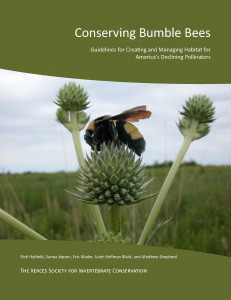
We hear a lot these days about colony collapse disorder and the problems facing honeybees. But many folks are not aware that our native bees are struggling as well. The nearly fifty species of bumble bees in North America are important pollinators of a wide variety of flowering plants, including crops such as tomatoes, blueberries, cranberries, and clover. Unfortunately, their numbers are declining, due to a number of factors such as the introduction of non-native pathogens, pesticide use, climate change, and loss of habitat.
Individual gardeners and landowners may not be able to address all these bumble bee threats, but they can take steps to provide the high-quality habitat bees need for survival, habitat that provides plants for nectar and pollen and sites for nesting and overwintering. To help this happen, the Xerces Society for Invertebrate Conservation has put together a helpful online publication (also available in a print copy). Conserving Bumble Bees: Guidelines for Creating and Managing Habitat for America's Declining Pollinators begins with an overview of the important role bumble bees play as pollinators and their natural history. It then outlines the various threats to bumble bee survival, including habitat fragmentation, harmful grazing practices, pesticide use, imported pests and diseases, competition with honey bees, and climate change.
Next come suggestions for ways in which gardeners and landowners can help. One way is by choosing native plants. These are plants with which the bees co-evolved and which they know how to use. And well-chosen native plants that are adapted to their site are likely to need less supplemental water, fertilizer, and pesticides to thrive. When planting horticultural varieties of flowers, the publication suggests using heirloom varieties, since the breeding of modern hybrids has often resulted in reduced amounts or a decrease in the nutritive value of pollen and nectar. Choose perennials over annuals, as they provide higher quality nectar, and select plants with flowers in the purples, blues, and yellows that bumble bees prefer.
To read more about the problems facing bumble bees and additional strategies for helping them; order a print copy of Conserving Bumble Bees; and find out more about the Xerces Society, go to: Xerces Society.